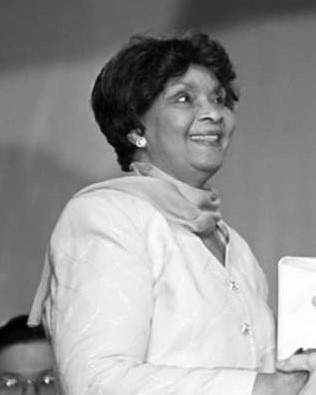Irene Morgan - Bus Rights Pioneer
Born: April 9, 1917, Baltimore, Maryland, U.S.A.
Died: August 10, 2007, Gloucester County, Virginia, U.S.A.
Irene Morgan was a courageous woman whose refusal to give up her seat challenged segregation laws and changed the course of American history.
Irene was born on April 9, 1917, in Baltimore, Maryland. She was one of eight children born to Robert and Ethel Amos, who had both been the children of enslaved people. Growing up during the Great Depression, Irene’s family faced hard times. Like many young people of her generation, she left high school early to help her family. She worked a series of jobs, eventually finding employment on the production line at the Glenn L. Martin Aircraft Company. There she met a dock worker named Sherwood Morgan, whom she later married. The couple had two children together.
By 1944, Irene was living in Gloucester County, Virginia, to be near her mother after suffering a miscarriage. It was here that she would make a decision that helped change the course of American history.
On July 16, 1944, Irene boarded a Greyhound bus headed to Baltimore, Maryland, for a doctor’s appointment. She bought a ticket and sat in the section marked “colored,” as Virginia law required. About 30 minutes into the ride, a white couple boarded the crowded bus, and the driver ordered Irene and the woman next to her to give up their seats. Irene refused. She knew she had paid for her ticket, and she also knew that the bus was traveling across state lines. She believed that Virginia’s segregation laws should not apply to an interstate bus.
The driver pulled into Middlesex County, where a sheriff’s deputy boarded the bus and handed Irene a warrant for her arrest. She tore it up on the spot. When the deputy tried to remove her by force, she fought back, even kicking him. Eventually, more officers arrived, and Irene was dragged off the bus, arrested, and jailed in Saluda, Virginia.
Irene was charged with two offenses: resisting arrest and violating Virginia’s segregation laws. She pleaded guilty to resisting arrest and paid a fine, but she refused to admit guilt for breaking the segregation law. Instead, she decided to fight it. Her courage set in motion a legal battle that would reach the highest court in the United States.
At first, Irene’s case went before the Virginia Supreme Court, where she argued that state segregation laws placed an unfair burden on interstate travel. She lost that case, but she and her lawyers refused to give up. With the help of the NAACP, her appeal went to the U.S. Supreme Court. Her legal team was led by two important figures: William H. Hastie and Thurgood Marshall, who would later become the first Black U.S. Supreme Court justice.
On March 27, 1946, the case Morgan v. Virginia was argued before the Court. The lawyers explained that if every state along an interstate bus route enforced its own segregation laws, passengers would constantly be forced to move, creating confusion and unfair treatment. On June 3, 1946, the Supreme Court ruled in Irene’s favor by a 6–1 vote. The decision declared that segregation on interstate buses was unconstitutional.
Although this was a major victory, many Southern states refused to enforce the ruling. To test compliance, in 1947 a group of civil rights activists launched the “Journey of Reconciliation.” Sixteen men, both Black and white, rode buses through the South to challenge bus segregation directly. They faced arrests, but their actions built on the foundation Irene Morgan had laid.
After her historic case, Irene moved to New York City with her children. Sadly, her husband Sherwood died in 1948. A year later, she married Stanley Kirkaldy, with whom she shared many happy years. Remarkably, Irene returned to school later in life. At age 68, she earned a bachelor’s degree in communications from St. John’s University, and at 72 she earned a master’s degree in urban studies from Queens College.
Her bravery was recognized decades later. In 2001, President Bill Clinton awarded her the Presidential Citizens Medal, and in 2002, the NAACP honored her with the Freedom Fighter Award. She was also inducted into the Maryland Women’s Hall of Fame in 2010.
Irene Morgan Kirkaldy passed away in 2007 at the age of 90. Her defiance on a Virginia bus in 1944 paved the way for later activists like Claudette Colvin and Rosa Parks. Her case was cited in dozens of later decisions that helped dismantle segregation in America. Irene once said, “When something’s wrong, it’s wrong and needs to be corrected.” With that belief, she stood her ground, and in doing so, she helped change the nation.
References:
“The Black Library Irene Morgan Kirkaldy.” The Black Library , www.theblacklibrary.org/stories/black-activists-philanthropists/irene-morgan-kirkaldy.
Madeo. “Irene Morgan Arrested in VA for Refusing to Give up Seat for White Passenger.” Equal Justice Initiative , calendar.eji.org/racial-injustice/jul/16.
Swift, Jaimee. “Leading the Fight: How Irene Morgan Paved the Way for the Montgomery Bus Boycotts.” Black Women Radicals, Black Women Radicals, 16 Nov. 2021, www.blackwomenradicals.com/blog-feed/leading-the-fight-how-irene-morgan-paved-the-way-for-the-montgomery-bus-boycotts.
Key words:
Civil Rights, Justice, Courage, Perseverance, Freedom, Responsibility, Challenge Injustices, Stand Up for Your Beliefs
Explore ARTEFFECT projects about this Unsung Hero:
Irene Morgan Artworks
- Collections: Art Gallery, Unsung Heroes

